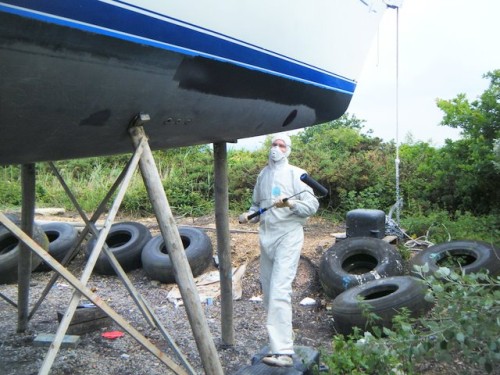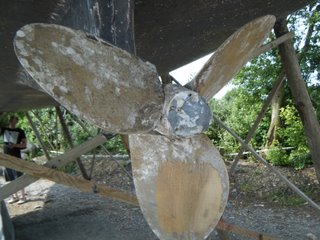Pegasus - UK to Australia

Who: Sally and Hamish
Port: Lymington, UK
Past entries
Videos and links
27 December 2010 | Gold Coast, Australia
11 October 2010 | Albufeira, Portugal
06 September 2010 | Portugal
28 August 2010 | Portimao, Portugal
27 August 2010 | Portimao, Portugal
23 August 2010 | Portimao, Portugal
12 August 2010 | Cascais, Portugal
10 August 2010 | Camarinas, Spain
08 August 2010 | Camarinas, Spain
02 August 2010 | Portsmouth
24 July 2010 | Lymington
23 July 2010 | Lymington, UK
20 July 2010 | Lymington
17 June 2010
16 June 2010 | Lymington
07 June 2010
10 May 2010
27 April 2010 | London, UK
20 April 2010 | Lymington, UK
09 April 2010 | London, UK
Pegasus out of the water
16 June 2010 | Lymington
Author: Hamish

Pegasus came out of the water at the end of May and sat on the hard drying out, whilst I sailed back across the Atlantic on the 38' Westerly, called Dances with Waves.
Upon my return to the UK, it was all hands on deck. The first job on the list was to clean 2 years of growth off the bottom, you can see some 'before and after' shots in the Gallery.
The boat was taken back to gel coat and antifouled by the previous owner in September 2008, so all we had to do was clean it and give it another coat of antifoul. The antifoul was probably passed its use by date and small barnacles had started to grow like freckles all over the bottom. I thought these would come off easily when dried, but it was the exact opposite - they ended up being like little pieces of cement. After a little trial and error the best method we found for getting them off was to wet the surface and to use a paint scraper to scrape them off. We then roughed up the surface with green Scotch Brite scourers, ready for the new coat.
Before we applied the new coat of antifoul, it was time to cut and polish the gelcoat above the waterline. This was achieved using Farecla G3 cutting compound and a lambs wool bonnet on an electric polisher. This was a massive task to undertake on my own, but managed to finish it 4 days. Holding a 5kg polishing machine above your head is not fun! Not sure when the last time the boat was polished, but the end result turned out OK. Achieving a perfect result is not easy because of the numerous variables, such as amount of cutting compound to use, spin speed, pressure, amount of water, etc. There were a number of areas where it was much harder like where the fenders had been rubbing against the side. I think fender socks could be a good investment to reduce this damage.
We also replaced the prop anode, the main anode and the bow thruster anode, which didn't look like it had been replaced for some time. Whilst preparing for the antifoul, I noticed one of the forward heads skin fittings looked a bit loose. Upon further investigation, I found that the nut had corroded through and would have given way at any time. The local chandler had a different replacement fitting which meant having to cut a keyway into the hull. I did this and then proceeded to put it all back together. One of the boat yard guys had given me a tube of special loctite sealant which once applied I managed to get the nut done up ¾ of the way, before it locked so tight it wouldn't go backwards or forwards. I ended up having to cut the whole fitting out and start again. Luckily another chandler had the same brand as the original and I was able to get it in after another couple of attempts.
Sally scraped the props clean, and then polished it with very fine sandpaper, before buffing it with Brasso. These will be the shiniest props in the Atlantic, they look good as new.


Finally I was ready to apply the antifoul. After dressing appropriately in the space man suit, including gloves, glasses and face mask, the boat got 2 coats at the waterline, 2 coats on the rudder and keel and a final coat on the remainder. We used International Unipro as this is what the previous owner had used so no compatibility issues. We got great service from boatpoint.co.uk and it came in about 25% cheaper than anywhere else.
For most of the week we stayed on the boat, which was slightly disconcerting, considering that the wind was howling and we were precariously perched up on timber posts. You could feel the boat moving quite a lot. Glad not to have to do this again in a hurry.
Everything on a boat takes time. I took the props off the bow thruster as they needed a good clean but when I went to put them back together I noticed that each prop was a different hand. I went and spoke to the onsite Volvo dealer who deals with QL bow thrusters. After several phone calls and hour going through manuals we finally worked it out.
Pegasus went back in the water on Tuesday, with the wind at 25knots, but I successfully moored it in a new berth without damaging the newly polished sides.
Lessons learnt. As this was first time I had undertaken this, there were a number of things I learnt.
1) Remove any growth before it has a chance to dry out.
2) Polish the gelcoat from the top down but if you have a white or light coloured boat with which has a coloured strips around it, do the strip first, otherwise you may get little specs of colour over the white
3) It takes a lot of effort and time, and for some reason all your friends have better things to do!
4) If you have twin prop thrusters, mark which goes on each side.
5) Wear heaps of protection, this stuff is toxic.
Upon my return to the UK, it was all hands on deck. The first job on the list was to clean 2 years of growth off the bottom, you can see some 'before and after' shots in the Gallery.
The boat was taken back to gel coat and antifouled by the previous owner in September 2008, so all we had to do was clean it and give it another coat of antifoul. The antifoul was probably passed its use by date and small barnacles had started to grow like freckles all over the bottom. I thought these would come off easily when dried, but it was the exact opposite - they ended up being like little pieces of cement. After a little trial and error the best method we found for getting them off was to wet the surface and to use a paint scraper to scrape them off. We then roughed up the surface with green Scotch Brite scourers, ready for the new coat.
Before we applied the new coat of antifoul, it was time to cut and polish the gelcoat above the waterline. This was achieved using Farecla G3 cutting compound and a lambs wool bonnet on an electric polisher. This was a massive task to undertake on my own, but managed to finish it 4 days. Holding a 5kg polishing machine above your head is not fun! Not sure when the last time the boat was polished, but the end result turned out OK. Achieving a perfect result is not easy because of the numerous variables, such as amount of cutting compound to use, spin speed, pressure, amount of water, etc. There were a number of areas where it was much harder like where the fenders had been rubbing against the side. I think fender socks could be a good investment to reduce this damage.
We also replaced the prop anode, the main anode and the bow thruster anode, which didn't look like it had been replaced for some time. Whilst preparing for the antifoul, I noticed one of the forward heads skin fittings looked a bit loose. Upon further investigation, I found that the nut had corroded through and would have given way at any time. The local chandler had a different replacement fitting which meant having to cut a keyway into the hull. I did this and then proceeded to put it all back together. One of the boat yard guys had given me a tube of special loctite sealant which once applied I managed to get the nut done up ¾ of the way, before it locked so tight it wouldn't go backwards or forwards. I ended up having to cut the whole fitting out and start again. Luckily another chandler had the same brand as the original and I was able to get it in after another couple of attempts.
Sally scraped the props clean, and then polished it with very fine sandpaper, before buffing it with Brasso. These will be the shiniest props in the Atlantic, they look good as new.
Finally I was ready to apply the antifoul. After dressing appropriately in the space man suit, including gloves, glasses and face mask, the boat got 2 coats at the waterline, 2 coats on the rudder and keel and a final coat on the remainder. We used International Unipro as this is what the previous owner had used so no compatibility issues. We got great service from boatpoint.co.uk and it came in about 25% cheaper than anywhere else.
For most of the week we stayed on the boat, which was slightly disconcerting, considering that the wind was howling and we were precariously perched up on timber posts. You could feel the boat moving quite a lot. Glad not to have to do this again in a hurry.
Everything on a boat takes time. I took the props off the bow thruster as they needed a good clean but when I went to put them back together I noticed that each prop was a different hand. I went and spoke to the onsite Volvo dealer who deals with QL bow thrusters. After several phone calls and hour going through manuals we finally worked it out.
Pegasus went back in the water on Tuesday, with the wind at 25knots, but I successfully moored it in a new berth without damaging the newly polished sides.
Lessons learnt. As this was first time I had undertaken this, there were a number of things I learnt.
1) Remove any growth before it has a chance to dry out.
2) Polish the gelcoat from the top down but if you have a white or light coloured boat with which has a coloured strips around it, do the strip first, otherwise you may get little specs of colour over the white
3) It takes a lot of effort and time, and for some reason all your friends have better things to do!
4) If you have twin prop thrusters, mark which goes on each side.
5) Wear heaps of protection, this stuff is toxic.
Comments
| Vessel Name: | Pegasus |
| Vessel Make/Model: | 2002 Beneteau 50 |
| Hailing Port: | Lymington, UK |
| Crew: | Sally and Hamish |
| About: | |
| Extra: |
Gallery not available

Who: Sally and Hamish
Port: Lymington, UK
